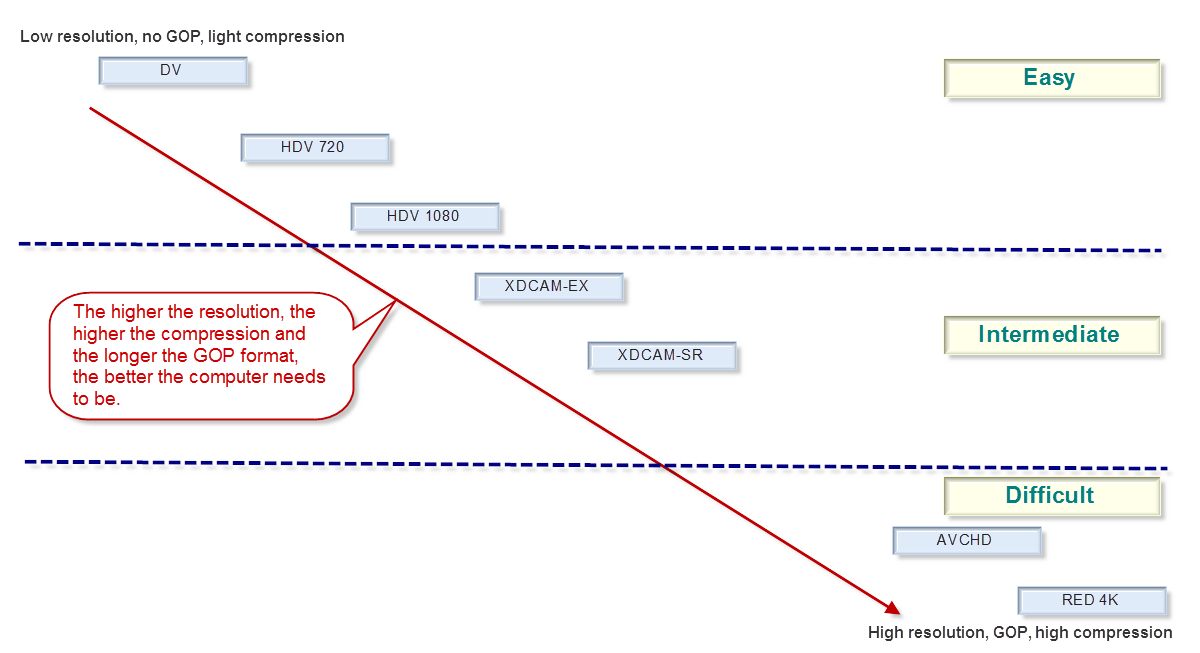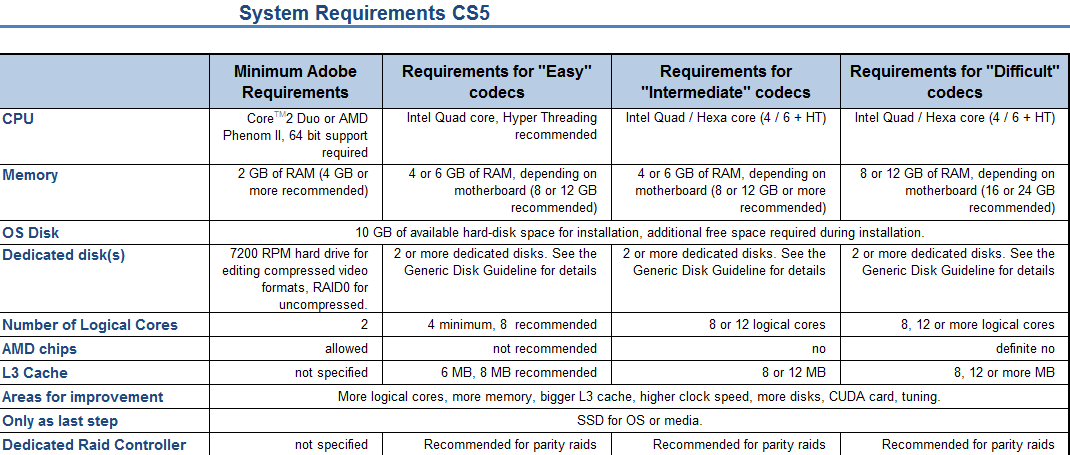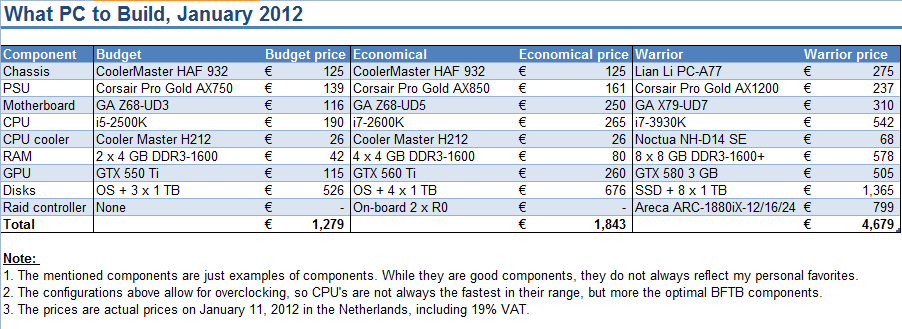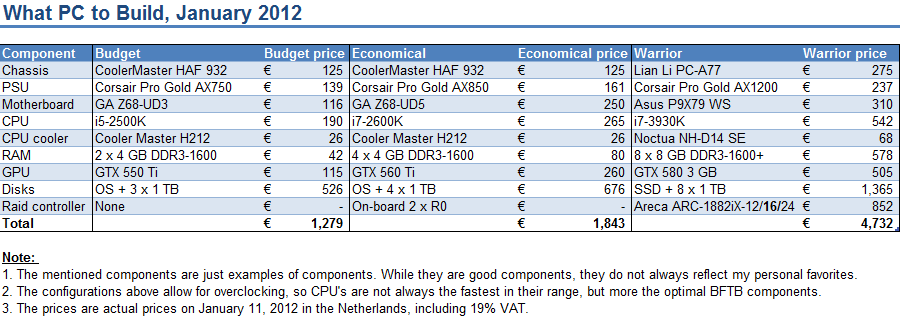- Home
- Video Hardware
- Discussions
- Re: What PC to build? An update...
- Re: What PC to build? An update...
What PC to build? An update...
Copy link to clipboard
Copied
What PC to build, updated January 2012
A question often asked is what system to build for NLE.
The previous article about this topic dates back to March 2010, so it was due an update because there were so many new developments in the past two years, including CS5.5
Basically you can think along three roads, a budget PC, an economical PC and the warrior PC. Notice that MAC is not mentioned here. There are three reasons for that, one is I'm not qualified to really advise on MAC's, two is that they are way overpriced and three they are severely limited in component choices. So this is all about PC.
Whether you want to have a budget, economical or warrior PC, there are a number of common components that you will always need, a case, a PSU, CPU cooler, monitor, keyboard, mouse, DVD/BR burner and stuff like that so I'm not going into those components, with the exception of case, PSU and CPU cooler.
CASE:
While the case of your choice is often determined by looks and what appeals to you (or your CFO, the wife), I want to stress that for all categories, budget, economical or warrior, it is better to use a BIG tower, instead of a mid tower.
Why, you may wonder. Actually there are a lot of reasons. Mid towers can limit your choices in CPU coolers, because the case is not wide enough to install certain CPU coolers. The height of the cooler does not fit in the case. They can limit your choice of video card, because these have grown in length significantly and mid towers often do not allow the installation of certain video cards due to the limited depth or prevent you from installing hard disks in certain slots. Mid towers will limit your expansion capabilities (less drive cages), make installation of components more difficult, have limited cable management features, have limited airflow and tend to become hotter than big towers and thus more noisy (the fans need to run at higher speed) and limit overclockabilty.
A BIG tower is the (only) way to go.
PSU:
The PSU is one of the most crucial components in any system but also the one component most often overlooked. A good PSU will give you years of reliable work on your PC, a suboptimal or mediocre PSU will give you tremendous headaches and unexplainable crashes, hangs or errors, causing you to miss deadlines.
Go to eXtreme Power Supply Calculator Pro v2.5 and get the Pro version. Enter all your components, including planned expansions, set the Motherboard to High End - Desktop, set the CPU Utilization (TDP) to 100%, set System Load to 100% and Capacitor Aging to 30% and press the Calculate button. Add 10 - 15% to this Wattage for safety and note the required amperage on the various rails (+3.3V, +5V and +12V). Based on these figures, select a good GOLD label PSU, that meets the total wattage and the amperage on each rail. It is your best guarantee for long and reliable, troublefree editing.
Budget, economical or warrior system
Before going into these three systems, you can consider them to be a rough 'Best-buying Guide', let me remind you of the basic practical system requirements for CS5.5 and consider your own workflow to interpret these charts.
It starts with the codec:

Since DSLR is getting so popular, let me remind you that this is ranked under the 'Difficult' codecs and P2 is an 'Easy' codec. The more difficult the codec you use, the higher the system requirements. See:

For the full article, see Adobe Forums: System requirements for CS5
As a rough translation from 'Easy', 'Intermediate' and 'Difficult' to the kind of system you want to build, you could say that 'Easy' can be handled quite well with a 'Budget' system, 'Intermediate' is best handled by an 'Economical' or better system and 'Difficult' requires an 'Economical' or better system. A 'Budget' system may struggle with the load of such 'Difficult' codecs.
Note that in the following table, I have mentioned components in each category. These are just examples of what could fit in each category, they are not necessarily a combination of components that I would build per se.
Also note that I have not chosen the fastest CPU in each category, but only unlocked CPU's. Each can be overclocked for optimal results and then will deliver a better Bang-For-The-Buck (BFTB) than the highest clocked CPU in that range. Finally, note that the budget system can benefit from increasing memory to 4 x 4 GB for only € 38 extra. That is the weakest link in the budget system.
Prices mentioned are current day prices in the Netherlands (01-11-2012) including 19% VAT.
Here are my suggestions:

The main difference in comparison to the previous guide, is that the i7-3930K appears to be faster and better affordable than a dual Xeon X5680 system.
Anyway, I hope this helps people comtemplating a new system to get the right components in an affordable system.
Copy link to clipboard
Copied
Nice Job Harm!
Scott
ADK
Copy link to clipboard
Copied
Nice job on the chart, Harm! However, some of the "easy" codecs are nowhere near as easy as the chart seems to indicate simply because some of those codecs actually require massive disk performance and size just to be handled properly. And DV and HDV is "easy" only because of their lower resolution and moderate-to-high compression (these codecs are limited to 25 Mbps total). Less-compressed codecs (even at extremely low resolutions) require much, much more disk space - and thus, much, much higher disk I/O system performance.
And "difficult" codecs are "difficult" due to the CPU horsepower that's often required of them. And AVCHD not only requires a relatively robust CPU to handle properly, but also require somewhat faster than "standard" disk performance due to the fact that most NLEs decompress and recompress video on the fly. (For Premiere Pro CS5.x, 4:2:0 AVCHD video gets decompressed to uncompressed 4:2:2 during the editing stage, and then gets recompressed into the desired output format during encoding. Some other NLEs are natively 4:4:4 RGB - and all material gets converted to 4:4:4 RGB in those NLEs and then to the desired output format on the fly.)
Copy link to clipboard
Copied
Agreed Randall and that is why I supplied the link to the Adobe Forums: System requirements for CS5 page, so people could read the context of these charts.
Example from the quoted article:
"For instance, uncompressed MS AVI SD material. No GOP structure, no compression, low resolution, that should be at the top left corner, right? Wrong. Uncompressed does not burden the CPU, but is a definite burden on the memory and disk I/O system."
Copy link to clipboard
Copied
Great article. Could it be true - Harm, ADK and Videoguys are now all on the same page! Intel 3930K as the way to go for the best perfomance.
Those interested can check out our latest DIY9 sneak peak machine based on the new Intel Core i7 Sandy Bridge-E 3930K running on Asus P9X79
Gary
Copy link to clipboard
Copied
So it would seem…
Still selling a good amount of 2600ks however
The X79 has not been without its own set of issues and honestly its been the hardest product launch to date
Copy link to clipboard
Copied
Our customers are finding the 2600Ks are an excellent choice for budget systems.
What kind of stuff are you running into with the X79s? Anything you can share here?
Gary
Copy link to clipboard
Copied
A lot of heat issues not just the CPU but memory, memory controller etc,etc
We build very quiet systems
A lot of crap bios from manufacturers, compatibility issues with Raid Cards, Capture cards, Pro Audio interfaces heck even eSata cards and firewire cards
Un stable over clocks on some boards.
Trying to not reveal what boards we are using but frankly we were left with having to use the very least fav manufacturer.
And I am very afraid of Quality control from them… this go round seems much better than previous experience (numerous bad ones) so far we will see
Hoping my fav manufacturer will get their act together…
We try to use just one board for each platform for both Pro Audio and Pro video…
Copy link to clipboard
Copied
Still selling a good amount of 2600ks however
That makes perfect sense, Scott. I have no knowledge of your sales distribution over the various systems, but would not be surprised if it came out like this, in turnover volume, not in number of systems:
- Budget: 25 %
- Economy: 65 %
- Warrior: 10 %
Copy link to clipboard
Copied
HI Harm,
Way off…
Budget 3% still usually 2600 no OC with no raids just 3 drives
Economy 30% these are a lot of weekend warriors or hobbyist with money (2600k with 5 drives) mostly OCed
Warrior 30% (X79 platform 5 drives)
Warrior 35% (X79 platform with parity raids)
Absurd 2% (Dual Xeon 2 x 8 drive raids)
Scott
Copy link to clipboard
Copied
As usual, great job Harm, thanks!
Two suggested tweaks for your "Warrior" build list:
1) The motherboard that you spec'd, Gigabyte's GA-X79-UD7, only has 4 RAM slots and will not take the 8x8GB sticks you listed; note that Gigabyte's "lesser" UD5 board however does indeed have 8 RAM slots
2) Suggest ARC-1882 series controller cards; I'm not sure what all has improved, but it definitely has a better looking cooler than the 2 different styles of 1880ix heat sinks that Areca put out (1st had 2 small passive heat sinks and did not cool very well, 2nd had a large heat sink and cooled better). Neither is as effective for a workstation case as the old 1680ix design like I think that you use currently, which has 1 small passive heat sink + a 2nd fan cooled heat sink.
Jim
Copy link to clipboard
Copied
Jim,
Thanks for your remarks. I have adjusted the suggestions accordingly.

What always surprises me is the old adagio that the system you really want is around $ 5 K. This was true in 1980, in 1990, in 2000 and now still holds.
Copy link to clipboard
Copied
thanks to Harm and the other guys for that post.
I am situated in "warrior" running 64bit, I7-960, 24 GB RAM, 7 TB Raid Areca 1680ix, 2x 570 Geforce. OC is necessary.
Footage XDCAM and 10bit uncompressed or PRORES, i do huge color corrections and also special effects in After Effects.
I want to upgrade to ASUS P9X79 Asus WS and I-3930 (or 3960). You suggested 64 GB 8x8 1600+ RAM.
As i found for the moment 8x8 GB stricks seems to be expensive. They are situated in about EUR + 1.000 (Gskill DDR 3-1600 CL 10-10-10-30).
Can another RAM solution or combination be found for a balanced system. Which RAM is BFTB, but not having a bottelnec.
thanks
klfi
Copy link to clipboard
Copied
32gig should be more than plenty for most users even with CS6 using even more ram
Scott
ADK
Copy link to clipboard
Copied
Speaking of CS6, and taking this thread OT, I am nervous about Adobe's recently announced more draconian policy with upgrade paths. Specifically, that CS5 to CS6 is going to come with the full upgrade discount, and that it won't be limited to CS5.5 owners.
Getting back on topic, I am really pleased with my 3930K system now the bugs have been ironed out, and it is working really nicely. I have seen pretty high CPU usage while exporting, but never more than half of the 32Gb RAM.
Copy link to clipboard
Copied
They just reversed a decision about upgrade eligibility, and will continue to offer discounts three versions back. I suspect it will be less of a discount the further back you go, but a discount nonetheless.
Found it! Here it is: CS6
Copy link to clipboard
Copied
Thanks for that.
Copy link to clipboard
Copied
Klaus,
Have a look at the G.Skill RipjawsZ F3-10666CL9Q2-64GBZL, around € 470 here now for 8 x 8 GB, but only 1333. You have to look more closely for 1600+ memory.
Copy link to clipboard
Copied
Klaus,
Here is what I would get right now for $324 USD (if I could afford the rest of your proposed system), then you could always upgrade if we really find some advantage.
Copy link to clipboard
Copied
Thanks Bill and Harm for yr replies.
I have read, studied and learned a LOT from this forum about CPU, mainboards drives, there configuration, Raid and controllers, grafic cards, cases, cooling, win7 config and tools, BFTB..... and i am now able to understand this part of balanced System ...and for me important - also to work with in an understandable way.
I learned how important in using CS5.5 and AE is a BALANCED system, having as less bottlenecks as possible. In PPBM5 i found also rules.
Is there any thread or posts where i can get more knowledge about RAM DIMM3 in a balanced CS 5.5 system (not gaming). I am interest to get to know to learn and understand the relation CPU to RAM-sticks, the meaning of 1333, 1600, 1800, 1833 and so on. Also what is and what means timing and CL (9-9-9-24, 10-10-10-30 clock ??).
Where i have to search?
What i understand about RAM in general is "more is better" and "only use one set and do not mix" but i am not able to work with RAM in a understandable way.
Thanks for all recommendations
Klaus
Copy link to clipboard
Copied
Klaus,
Regarding what RAM specifications are important for Premiere Pro:
- size is way more important than speed
- speed is way more important than CAS (latency timings, etc.)
- don't forget rated voltage too since you are overclocking; when you have lower voltage RAM (I use 1.5v. on X58) I believe that the CPU memory controller is not taxed as hard as with higher voltage RAM
It seems that the "record-breaking" OC crowd and gamer enthusiasts do buy really expensive RAM with super high speeds and low timings, but they are building systems with MUCH less RAM than those of us here on the Adobe HW forum. Regarding more information about timings, just Google "RAM CAS timing vs RAM speed" and you can surf for a long time.
Frankly, I thought that RAM speed would really impact Adobe Premiere Pro, but based on numerous runs using PPBM5 I can say that RAM size is very important until you hit 16GB (for CS5, possibly higher for CS5.5 and the CS6 of the future) and RAM speed differences were so slight they were difficult to even notice.
I have read that AE can utilize more RAM than PPro if that is important to your workflow - simply do what you do and monitor the memory usage by your PC using the Task Manager Performance tab.
Finally, why don't you just pop a 6-core 32nm CPU into your current PC and buy some more time before doing a complete motherboard, RAM, CPU upgrade? That will give you 50% more cores and be a WAY easier migration path than a complete new PC. The rest of your system is quite strong and while the new X79 6-core may be a bit faster than adding a 6-core 32nm to your existing X58, the serous speed improvements are likely still many months away with X79 motherboard designs still maturing and 8-core CPUs (or more!?) being added to the mix.
Jim
Copy link to clipboard
Copied
Thanks Jim
for yr help and recommendations. Maybe you are right, i will think about and google about RAM v speed. I did befor but a little difficult to understand.
So you mean only to upgrade to I7-980x extrem edition or I7 990x extreme edition.
CUPID says my current RAM is DDR3 24 GB channels triple, NB Frequence 3200 MHz, DRAM 800.0 MHz, FSB DRAM 210, 9-9-9-24, 128 clocks command rate 2T.
During rendering a PP 5.5 timeline recurcemonitor says used RAM 22% and CPU +/- 99%.
During exporting same timline to h264 (35-40 Mbts) recource monitor says RAM 40-50% and CPU 90%.
Is this balanced ?
your recomandation
don't forget rated voltage too since you are overclocking; when you have lower voltage RAM (I use 1.5v. on X58) I believe that the CPU memory controller is not taxed as hard as with higher voltage RAM
maybe i do not understand in the right way becouse less of general knowlede.
For DRAM BusVoltage in BIOS mainboard ASUS P6T6 WSrevolution i use 1,5 volt.
CPU Ratio is 25.0
BCLK Freq is 160
PCIE is 100
DRAM Freq is DDR3-1604 MHz
DRAM timing control i did not change an touch.
Am i on the right way?
Thanks for your time
Klaus
Copy link to clipboard
Copied
Klaus,
Regarding which 6-core, that probably depends largely on what options you have available and at what price! I selected the i7-970, which along with the i7-980 are less expensive CPUs, but more time consuming to overclock vs. the i7-980x and i7-990x. When I purchased it, the 980x and 990x were over $500 more expensive, but it seems that with the advent of the X79 stuff the 980x and 990x prices have dropped considerably.
Regarding does you system sound balanced, yes, from what your reporting, it sounds pretty good. And since your CPU is hitting close to 100%, it would seem that your drives are keeping up.
I don't want to comment regarding specific ratios, BCLK, etc. since various motherboard designs do have slightly different designs and setup options and also because each and every CPU can vary slightly due to the manfacturing process. As you are already at 4 GHz, with RAM at 1604 MHz, you are indeed doing well with your current setup. When I made the move from a i7-950 to a i7-970, the maximum stable OC speed that I got was just about identical even with 50% additional cores on the 970. I would contribute this to the smaller die size of the 970 design; it is 32nm, or the same as Sandy Bridge CPUs.
I personally have not done any DRAM timing control tweaking. I have a Gigabyte board and simply set the multiplier and have the motherboard adjust the timings automatically.
Cheers,
Jim
Copy link to clipboard
Copied
Thanks Jim
Klaus
Copy link to clipboard
Copied
Klaus,
With regard to your question about memory, let me put it this way, in terms of impact on performance:
- Maximize the amount of memory. 16 GB is much faster than 8 GB, 24 GB is much faster than 12 GB. Note however, that not all DIMM slots need to be populated to get the best performance. If you have a X79 mobo with 8 slots, 4 x 8 GB is as fast as 8 x 4 GB, but in the first case you have the option to expand to 64 GB in the future. Also note that there are diminishing returns from increasing memory say from 32 to 64 GB for PR. For AE there is still a performance gain, but less so in PR. But one can use part of that large amount of memory in the case of 64 GB to be used as a kind of RAM disk to further increase performance. It is also important to only use a number of sticks in multiples of the memory architecture, so if you have dual channel memory, only use multiples of 2 sticks, with triple channel memory, only use multiples of 3 sticks and with quad channel memory, only use multiples of 4 sticks. Always populate memory banks completely.
- Faster memory is always preferred over slower memory if you overclock your system. Faster memory has no use at all if you run the system at stock speed. If you run memory at standard DDR3-1333 speed, it is a waste of money to invest in DDR3-1866 or even faster sticks. But if you overclock memory to run at higher speeds, then there is a further performance gain. Do not expect that 30% faster memory will result in 30% system performance gain. It can possibly be around single digit improvements, like 3% system gain with 30% faster memory.
- Faster timings are the least important. Timing differences like CAS 9 versus 10 are marginal at most and only result in hardly noticeable performance gains that may be measured as 1% or less.
Hope this explains a bit where priorities are for choosing the right memory sticks.
Find more inspiration, events, and resources on the new Adobe Community
Explore Now